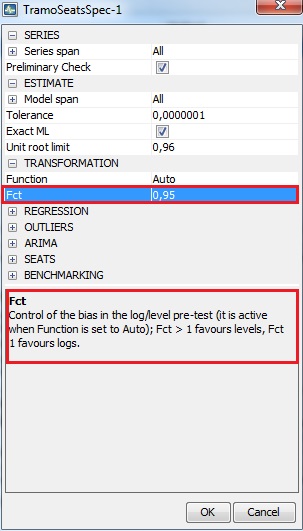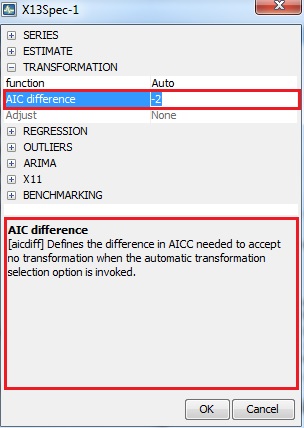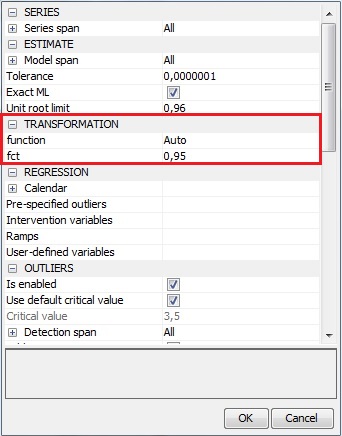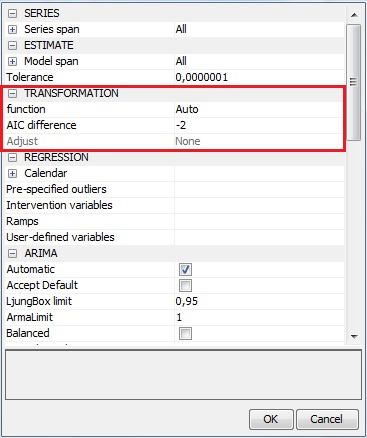Transformation choices
The log transformation of the original data is an option that is often applied to achieve a stationary autocovariance function. The decision concerning logging (or not) of a time series has a great impact on seasonal adjustment outcomes1. JDemetra+ offers two options: logging (which means that the multiplicative decomposition is used) or no transformation (the additive decomposition is used). The selection of the transformation type can be done automatically, on the basis of the outcome of a log-level test.
The test used by TRAMO-SEATS is based on the maximum likelihood estimation of the parameter $\lambda$ in the Box-Cox transformations (which is a power transformations such that the transformed values of time series $\text{y }$are a monotonic function of the observations, i.e.:
\[y_{i}^{\alpha} = \left\{ \frac{\left( y_{i}^{\alpha} - 1 \right)}{\begin{matrix} \lambda \\ \log{y_{i}^{\alpha},\lambda = 0\ } \\ \end{matrix}} \right.\ ,\ \lambda \neq 0\]The automatic procedure first fits two Airline models (i.e. ARIMA (0,1,1)(0,1,1)) on the time series: one in logs ($\lambda = 0$), the other without logs ($\lambda = 1$). The test compares the sum of squares of the model without logs with the sum of squares multiplied by the square of the geometric mean from the model in logs. Logs are taken in case the last function is the maximum2. The parameter fct controls the bias in the log/level pre-test (the function is active when Function is set to Auto); fct > 1 favours levels, fct < 1 favours logs. This test is used for modelling with the TRAMO model.

The Transformation options for the TRAMO-SEATS method
The test used by X-13ARIMA-SEATS is based on the AICC information criteria3. To choose the transformation type, X-13ARIMA-SEATS fits the RegARIMA model to the untransformed and the transformed series. X-13ARIMA-SEATS will choose the log transformation except when4:
\[\text{AICC}_{\log} - \text{AICC}_{\text{no\ log}} < \Delta_{\text{AICC}}\]where:
$\text{AICC}_{\text{no\ log}}$ is the value of AICC from fitting the RegARIMA model to the untransformed series;
$\text{AICC}_{\log}$ is the value of AICC from fitting the RegARIMA model to the transformed series;
$\Delta_{\text{AICC}}$ is the threshold value; $\Delta_{\text{AICC}}$> 0 favours levels and $\Delta_{\text{AICC}}$ < 0 favours logs.
The RegARIMA model used in the test is the one specified in the ARIMA part of the specification. If model is specified then the (0,1,1)(0,1,1) model is used. This test is used for modelling with the RegARIMA model.

The Transformation options for the X-13ARIMA-SEATS method
According to the ESS Guidelines on Seasonal Adjustment (2015), the automatic procedures should be applied for the transformation choice, however in case of the most problematic series the manual selection is recommended. The manual selection of the transformation is usually made in the specifications used for a regular data production.
-
To determine the transformation choice first create and open a new specification.
-
For tramo and tramoseats specifications from the Transformation section choose the function option and input the fct parameter’s value. Click OK to confirm your choice.

Transformation’s option for the tramoseats specification
-
For the regarima and x13 specifications from the Transformation section choose the function option and Aic difference parameter’s value. Click OK to confirm your choice.

Transformation’s option for X13 specification
It is also possible to change the transformation’s options in the currently used specification (see Defining and modifying a specification scenario, step 4).